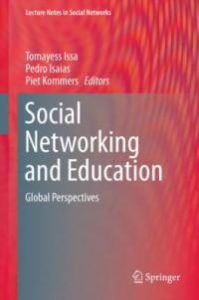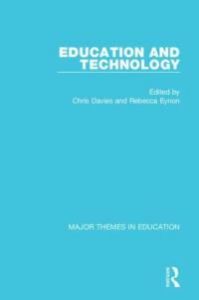What better way to start off this semester than with some new acquisitions! The OISE Library has plenty of new content for reading in both English and French.
 The Finance of Higher Education: Theory, Research, Policy & Practice. 2001. Editors Michael B. Paulsen and John C. Smart have brought together a host of different authors in the field of finance in higher education and economics to build a collection of chapters that are meant to educate the reader about the paradigms and future directions of finance in higher education. These are bolstered by a detailed case study conducted by contributors David W. Brenemen, James L.Dotti and Lucie Lapovsky that ultimately suggests a new model for pricing and enrollment practices. The book is split into five parts containing a total of fifteen chapters. From the history of the field in the United States of America to the current state of finance in higher education in the twenty-first century, this volume covers a wide range of topics. Interested students will find the variety of content engaging. This volume is coming from a decidedly American perspective; many of the themes do have a parallel in Canada, but students will have to take care to note differences in the topic internationally. The publication date of this book is of note: it was published in 2001, before the economic crisis of 2008 and the realities it discusses have no doubt changed significantly. That being said, the basic theories are still valid, and this book will still provide a good introduction to the topic to any interested students.
The Finance of Higher Education: Theory, Research, Policy & Practice. 2001. Editors Michael B. Paulsen and John C. Smart have brought together a host of different authors in the field of finance in higher education and economics to build a collection of chapters that are meant to educate the reader about the paradigms and future directions of finance in higher education. These are bolstered by a detailed case study conducted by contributors David W. Brenemen, James L.Dotti and Lucie Lapovsky that ultimately suggests a new model for pricing and enrollment practices. The book is split into five parts containing a total of fifteen chapters. From the history of the field in the United States of America to the current state of finance in higher education in the twenty-first century, this volume covers a wide range of topics. Interested students will find the variety of content engaging. This volume is coming from a decidedly American perspective; many of the themes do have a parallel in Canada, but students will have to take care to note differences in the topic internationally. The publication date of this book is of note: it was published in 2001, before the economic crisis of 2008 and the realities it discusses have no doubt changed significantly. That being said, the basic theories are still valid, and this book will still provide a good introduction to the topic to any interested students.
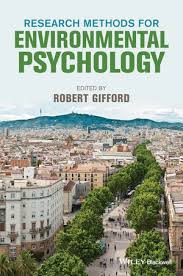 Research Methods for Environmental Psychology (2016). Editor Robert Gifford’s charming introduction sets the tone for the rest of the work: engaging and informative, but very human, this book is an excellent new acquisition. Environmental psychology studies the ways in which people interact with their physical environments. How is our behaviour impacted by the physical environments that we navigate on a day-to-day basis? How can design be improved to not only better accommodate people but also preserve the environment? These are some of the questions explored in this book in a down to earth (quite literally!) and almost conversational way. Robert Gifford embraces the perspectives and experiences of graduate students, allowing them to write chapters reflective of their experiences within the field that provide both factual knowledge and a personal touch. This book makes an excellent introductory textbook to the subject; it is compact while communicating a large amount of information in a reader-friendly way. Subjects such as research design, advanced statistics and meta-analysis are also touched upon in detail. Students interested in user experience, classroom design, green initiatives or general psychology will enjoy this new acquisition. Gifford has extensive experience in the field from the 1960’s onwards, and has witnessed the changes that the related methodology and nomenclature have undergone in the last several decades. This work appears to be a culmination of this experience, as he has shared his knowledge with the contributors. It is split into 20 chapters with an additional author index and subject index for the convenience of the reader.
Research Methods for Environmental Psychology (2016). Editor Robert Gifford’s charming introduction sets the tone for the rest of the work: engaging and informative, but very human, this book is an excellent new acquisition. Environmental psychology studies the ways in which people interact with their physical environments. How is our behaviour impacted by the physical environments that we navigate on a day-to-day basis? How can design be improved to not only better accommodate people but also preserve the environment? These are some of the questions explored in this book in a down to earth (quite literally!) and almost conversational way. Robert Gifford embraces the perspectives and experiences of graduate students, allowing them to write chapters reflective of their experiences within the field that provide both factual knowledge and a personal touch. This book makes an excellent introductory textbook to the subject; it is compact while communicating a large amount of information in a reader-friendly way. Subjects such as research design, advanced statistics and meta-analysis are also touched upon in detail. Students interested in user experience, classroom design, green initiatives or general psychology will enjoy this new acquisition. Gifford has extensive experience in the field from the 1960’s onwards, and has witnessed the changes that the related methodology and nomenclature have undergone in the last several decades. This work appears to be a culmination of this experience, as he has shared his knowledge with the contributors. It is split into 20 chapters with an additional author index and subject index for the convenience of the reader.
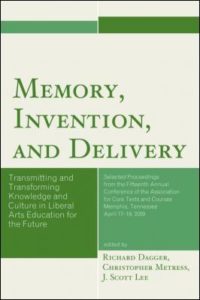 Memory, Invention, and Delivery: Transmitting and transforming knowledge and culture in Liberal Arts education for the future. Edited by Richard Dagger, Christopher Metress and J. Scott Lee, this book represents selected proceedings from a 2009 conference on the subject. This short volume is divided into six sections, including topics such as transmitting and transforming through core texts, freedom and happiness from the Renaissance to modernity and discussions of memory in the Liberal Arts disciplines. Each generation of scholars remakes their interpretation of the classical texts upon the which their disciplines are founded. It is this remaking and reinterpretation, which at times both rejects and allows these texts to stay relevant, that partly inspired this book. How is knowledge transformed through these generational differences? And how can we interpret the total of the many changes, challenges and interpretations that have come to us over decades and centuries? The authors discuss the isolation that current structures of higher education can breed; each discipline becomes further riddled with sub-specialties, which can create bottlenecks of information and innovation. Students hoping to teach Liberal Arts will enjoy this new acquisition.
Memory, Invention, and Delivery: Transmitting and transforming knowledge and culture in Liberal Arts education for the future. Edited by Richard Dagger, Christopher Metress and J. Scott Lee, this book represents selected proceedings from a 2009 conference on the subject. This short volume is divided into six sections, including topics such as transmitting and transforming through core texts, freedom and happiness from the Renaissance to modernity and discussions of memory in the Liberal Arts disciplines. Each generation of scholars remakes their interpretation of the classical texts upon the which their disciplines are founded. It is this remaking and reinterpretation, which at times both rejects and allows these texts to stay relevant, that partly inspired this book. How is knowledge transformed through these generational differences? And how can we interpret the total of the many changes, challenges and interpretations that have come to us over decades and centuries? The authors discuss the isolation that current structures of higher education can breed; each discipline becomes further riddled with sub-specialties, which can create bottlenecks of information and innovation. Students hoping to teach Liberal Arts will enjoy this new acquisition.
 Penser la Formation en Gestion: Repères Pour L’enseignement Supérieur. Jean-Pierre Béchard’s 2016 book, from the University of Montreal Press, will be of interest to students who are able to read French. This book examines the educational aspects of management schools over the last 25 years. How can the development and deepening of the theoretical underpinnings of management education be achieved with sustainable educational practices in mind? Béchard begins his first chapter with an interesting discussion of the linguistic nuances of the work education between English and French. The book is divided into eight chapters. It must be noted that while the book lacks a table of contents at first glance, it is actually present at the back of the book. This can make the work slow to navigate at times. It is equipped with several appendixes to aid and guide the reader, as well as short case studies interspersed throughout the chapters. The audience for this book is primarily academic, and is is not the work of an inexperienced author but of a long-time scholar.
Penser la Formation en Gestion: Repères Pour L’enseignement Supérieur. Jean-Pierre Béchard’s 2016 book, from the University of Montreal Press, will be of interest to students who are able to read French. This book examines the educational aspects of management schools over the last 25 years. How can the development and deepening of the theoretical underpinnings of management education be achieved with sustainable educational practices in mind? Béchard begins his first chapter with an interesting discussion of the linguistic nuances of the work education between English and French. The book is divided into eight chapters. It must be noted that while the book lacks a table of contents at first glance, it is actually present at the back of the book. This can make the work slow to navigate at times. It is equipped with several appendixes to aid and guide the reader, as well as short case studies interspersed throughout the chapters. The audience for this book is primarily academic, and is is not the work of an inexperienced author but of a long-time scholar.
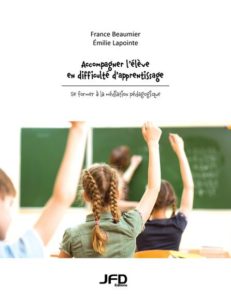 Another new French-language title at the OISE Library for December is France Baumier and Émilie Lapointe’s Accompagner L’Élève en Difficulté d’Apprentissage: se Former à la Médiation Pédagogique (2016). This short book is in the format of a softcover textbook, and is meant to teach teachers how to better their interventions when students are struggling. Part of the joy of teaching is the constant process of transformation and learning that teachers themselves undergo in the course of their careers, and this textbook is meant to help with one of these transitions. The work is separated into six chapters, each of which contain several parts or sub-themes. The larger themes covered include, but are not limited to: codes of ethics, the processing of information and cognitive processes among students. Students will find the exercises provided in the book helpful and stimulating; they have been carefully designed to improve learning outcomes for both students and the teachers themselves.
Another new French-language title at the OISE Library for December is France Baumier and Émilie Lapointe’s Accompagner L’Élève en Difficulté d’Apprentissage: se Former à la Médiation Pédagogique (2016). This short book is in the format of a softcover textbook, and is meant to teach teachers how to better their interventions when students are struggling. Part of the joy of teaching is the constant process of transformation and learning that teachers themselves undergo in the course of their careers, and this textbook is meant to help with one of these transitions. The work is separated into six chapters, each of which contain several parts or sub-themes. The larger themes covered include, but are not limited to: codes of ethics, the processing of information and cognitive processes among students. Students will find the exercises provided in the book helpful and stimulating; they have been carefully designed to improve learning outcomes for both students and the teachers themselves.
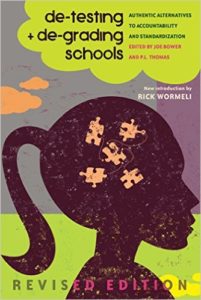 De-testing and de-grading Schools: Authentic Alternatives to Accountability and Standardization (2016). Editors Joe Bower and P.L Thomas have updated their past work into a new edition of this fascinating book. The book rests on the basic argument that the last century of testing and grading has been not only unsuccessful, but damaging to the state of education. The contrast between rigid testing and grading structures and the movement within education towards a more democratic and free approach to teaching is becoming more and more obvious as tests fail to produce encouraging results. There are eighteen chapters in this volume, which are divided into two parts: “degrading learning, detesting education,” and “de-grading and de-testing in a time of high-stakes education reform.” Rick Wormeli provides an excellent introduction to the book, in which he discusses his experiences in teaching standardized testing and points out that much of what these grades reveal are not competence, but compliance. Students will find this to be a refreshing read.
De-testing and de-grading Schools: Authentic Alternatives to Accountability and Standardization (2016). Editors Joe Bower and P.L Thomas have updated their past work into a new edition of this fascinating book. The book rests on the basic argument that the last century of testing and grading has been not only unsuccessful, but damaging to the state of education. The contrast between rigid testing and grading structures and the movement within education towards a more democratic and free approach to teaching is becoming more and more obvious as tests fail to produce encouraging results. There are eighteen chapters in this volume, which are divided into two parts: “degrading learning, detesting education,” and “de-grading and de-testing in a time of high-stakes education reform.” Rick Wormeli provides an excellent introduction to the book, in which he discusses his experiences in teaching standardized testing and points out that much of what these grades reveal are not competence, but compliance. Students will find this to be a refreshing read.
You can find these titles, and many more new additions to the OISE collection, on the ground floor of OISE Library. They will be available on the “New Acquisitions” shelf across from the reference desk.
Happy reading!
 Inclusive education has been particularly popular in the educational literature of the last several years, with a focus on technologies, special needs, second language learners and sensitivity. Along with the selection of materials already on display, there are many more books and resources to discover in the library, and an excellent selection of articles online.
Inclusive education has been particularly popular in the educational literature of the last several years, with a focus on technologies, special needs, second language learners and sensitivity. Along with the selection of materials already on display, there are many more books and resources to discover in the library, and an excellent selection of articles online. Similarly, differentiated education has been approached from subject specific viewpoints, such as math and English, as well as through the lens of social justice and technology. There are many more books available on the subject in the library, particularly in the Curriculum Resources section.
Similarly, differentiated education has been approached from subject specific viewpoints, such as math and English, as well as through the lens of social justice and technology. There are many more books available on the subject in the library, particularly in the Curriculum Resources section.






 Ever wondered how electricity is generated? Want to understand how motors work? Interested in building your own hand-crank motor? The
Ever wondered how electricity is generated? Want to understand how motors work? Interested in building your own hand-crank motor? The 